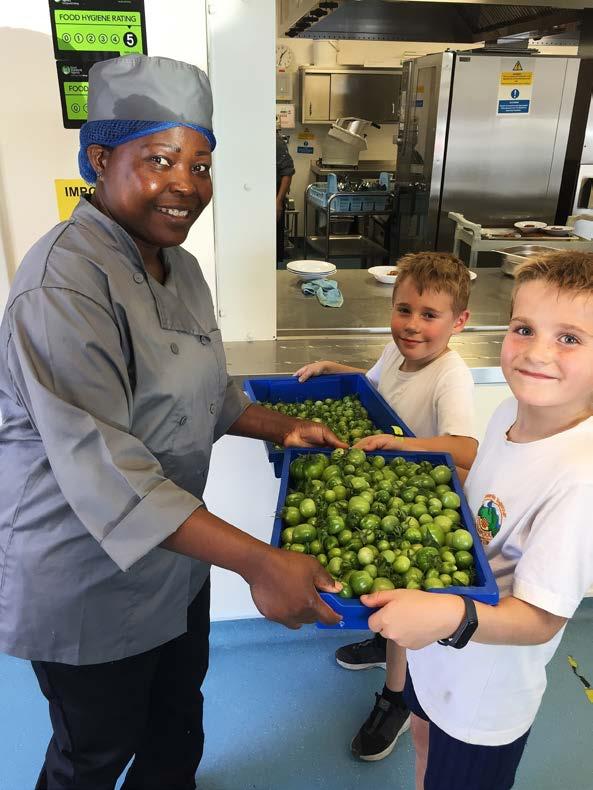
6 minute read
START GETTING YOUR KITCHEN READY NOW
Overview
If you’re already serving around 85 to 90% of pupils, you’re unlikely to see take up increase and will be able to manage. However, if take up is currently around 60 to 70%, you could have a big jump in the number of mouths to feed. This might seem daunting but you can start preparing now.
Advertisement
Sreshta, School Operations Manager at Chefs in Schools, says:
“WE EXPECT 10% OF FAMILIES/CARERS TO CONTINUE WITH PACKED LUNCHES DUE TO ALLERGIES OR FOR OTHER REASONS SO AN INCREASE IN DEMAND TO AROUND 90% IS LIKELY AND A FIGURE TO WORK TO.
AS A GUIDE, WE’VE FOUND A REASONABLE EXPECTATION FOR A KITCHEN TEAM IS TO PRODUCE BETWEEN 10 TO 14 MEALS PER LABOUR HOUR, WITH THE AVERAGE BEING 12 MEALS PER LABOUR HOUR. WHEN ESTIMATING DEMAND, LOOK AT WHAT’S ACHIEVABLE FOR YOUR TEAM BASED AROUND THIS FORMULA.”
FIRST STEPS - ASSESS CURRENT OUTPUT.
Determine how many children are fed each day. Work out the total number of hours the kitchen team works each day.
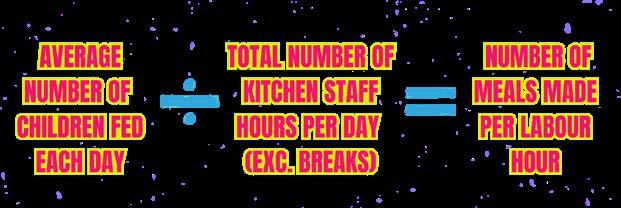
Take the number of children being fed, divide it by the total number of staff hours per day (minus breaks), this will equal the number of meals made by labour hour.
For example: A school with 272 pupils has 170 children who eat lunch.
There is a Head Chef, who works 7.30 to 2pm. A Sous Chef works 9am to 2pm. A Kitchen Assistant works 10am to 2pm. Minus breaks = 15 hours of kitchen time a day. 170 children divided by 15 labour hours worked = 11.3.
Conclusion: The team produces 11 meals per hour worked.
OTHER ISSUES TO CONSIDER
Estimate Labour Hours Needed Post September
To know how many labour hours are required to meet the expected demand of 90% of your pupils eating lunch, complete the following formula.
First, work out the figure for 90% of your pupils - this calculator will help: https://percentagecalculator.net/
Divide the figure by the number of meals currently made per labour hour. If you don’t know this, head back to page 7 for help.
The result shows how many labour hours will be needed to meet demand.
In our example school, the number of children needing lunch would increase from 170 to 244.
244 (number of children) divided by 11.3 (number of meals produced each hour) equals 21.5.
Conclusion: The team needs 21.5 hours of labour. They will need 6.5 more labour hours to meet demand or extra equipment to reduce workload.
Not every kitchen is equal. Other factors play a part:
• The amount of space your team has to get prepared ahead of time.
• If cleaning duties include the dining hall.
• Do they have the right equipment?
• Are they trained to use it?
To get the most effective ratio, we recommend auditing your equipment and training needs. Steps include:
• Assess existing equipment to see if it is effectiveequipment that isn’t working well means extra manual work, slowing the team down.
• Ensure the team have been trained on all equipment and get the best out of it.
• Invest in new equipment, e.g vegetable prep machines, to decrease workload.
These steps can increase productivity and decrease the need for more staff hours.
Notes On Kitchen Equipment
A kitchen team can only be truly effective if given suitable equipment and the training to use it. Before any additional staff recruitment, ensure that the kitchen has everything it needs - even small things like making sure you have enough utensils and crockery so they don’t have to be washed up during service, can make a big difference to time.
SRESHTA, SCHOOL OPERATIONS MANAGER AT CHEFS IN SCHOOLS, SAYS:
“INVESTING IN EQUIPMENT CAN BE DAUNTING BUT, OVER TIME, IT CAN SAVE MANY WORKING HOURS.”
YOUR ESSENTIAL TICK LIST.
√ Enough utensils and crockery for a full lunch service
√ Adequate fridge space for the team to prep ahead
√ Veg preparation machines
√ Sharp knives!
√ Gastronorm trays
OTHER EQUIPMENT THAT CAN HELP
√ Racking trolleys - these can stack trays and free up prep space
√ A bratt pan - this can replace a four or six burner range and make big quantities of food
√ A good oven - preferably a combination oven that cooks different items efficiently. Train the team on all of the above equipment.
OUR CHEF TRAINER, NERISSA, SAYS: “VEGETABLE PREP MACHINES ARE VITAL BECAUSE BUYING PREPARED VEGETABLES IS REALLY EXPENSIVE –AND NOT EVERYONE HAS KNIFE SKILLS, EITHER.”
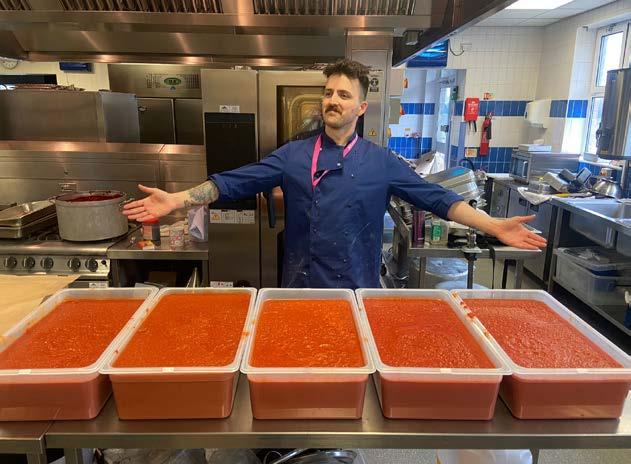
Staffing Requirements
Look at current staff structures/rotas, see if these can be adapted for better cooking, cleaning and service efficiency. E.g. change start and finish times to have more prep time first thing or more cleaning time later.
Assess Rotas
Someone on a 20-hour week contract should be working from 10am to 2pm. They’re in early enough to help prep, and can help clean up.
SCHOOL CHEF TRAINER ADAM SAYS: “IF EXISTING STAFF CAN’T WORK MORE HOURS, START RECRUITING ASAP SO AS TO HAVE PEOPLE IN PLACE STRAIGHT AWAY, RATHER THAN HAVING TO FALL BACK ON EXPENSIVE AGENCY STAFF.”
Head Chef Emma, from Newington Green Primary School, says some parents might want occasional shifts and to be called in to support when necessary.
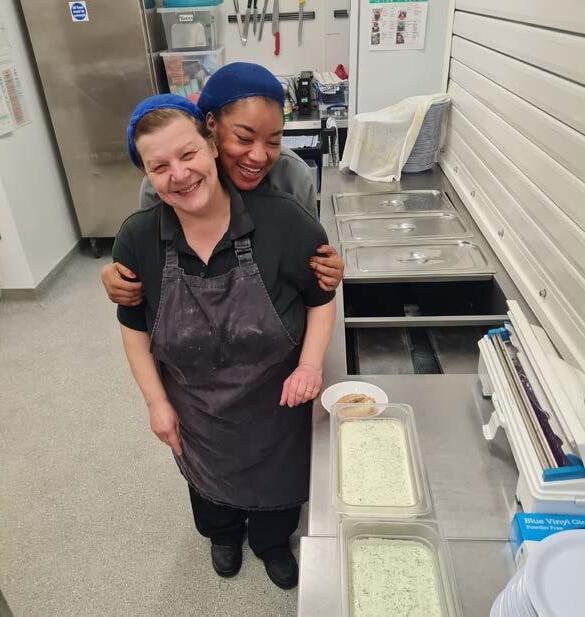
EMMA SAID: “IT GIVES THEM AN OPPORTUNITY TO UPSKILL AND RETRAIN AND SAVES US A FORTUNE IN AGENCY FEES SO IT’S WIN/WIN. THEY’LL ALSO BE FAMILIAR WITH THE SCHOOL, CHILDREN AND YOUR WAY OF WORKING IF YOU’VE TRAINED THEM.”
Tip: It is vital your team has enough time to clean up to maintain high standards of organisation and hygiene.
Utilise Kitchen Space
We’ve seen chefs cooking for hundreds of kids in kitchens no bigger than a glorified cupboard! Look at your space and think about how you can utilise it in a clever way.
Chefs - you understand the kitchen flow better than anyone, explain to the business manager or head teacher what is working and what could be improved.
Key considerations - how can you increase kitchen prep areas and refrigeration space?
Before buying equipment, consult the companies you’re going to purchase from. They can come in and look at the space and suggest what equipment you should purchase and what can work well.
Training The Kitchen Team
All of the staff and all of the equipment can only do so much - training is essential to build confidence, efficiency and staff retention.
There are lots of free training courses out there. For example, Westminster Kingsway College is offering free upskilling courses for all kitchen staff. You can also contact companies like Rational, who can offer training for kitchen teams.
Our charity offers in-depth training courses tailored to school chefs, head to: chefsinschools.org.uk to find out if they could be right for you.
Business Manager And Head Chef Communication

While increasing capacity, we advise regular check-ins between business managers and the head chef. These should be at least once a week to discuss staff wellbeing, workload and any challenges. With understanding, these challenges can be overcome. If problems are flagged early, then it is easier to plan around them and identify what resources are required.
Long term, we advise those check-ins continue every month. Dialogue and working together as a team is key to driving success, whether the kitchen team are employed directly by the school, or contracted to an outsourced provider. Great school food exists where there is cooperation between everyone involved!

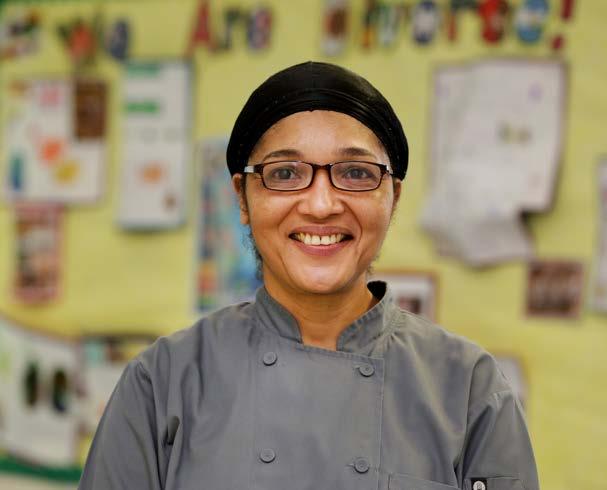
CHEF TRAINER ANDY SAYS: “IF YOU MAKE TOMATO PASTA ON A MONDAY, THERE’S NO REASON IT CAN’T BE A PASTA SALAD ON THE TUESDAY. ZERO-WASTE ISN’T JUST A BUZZWORD ANYMORE –IT’S VERY USEFUL FOR BUDGETS AND FOR FEEDING CHILDREN.”
Budgeting And Planning The Menus
Budgeting
Simple changes can make a big difference to budgeting.
• Avoid daily opt-in systems for school meals. Knowing how many kids are eating ahead of time aids budgeting, preparation and reduces waste.
• Switch to a system where families opt-in for the term.
• Engage with parents to explain this benefits the environment, school budgets and keeps school meal costs down.
Tip: Read our section on increasing take-up for help engaging with parents about the benefits of school food.
Menu Planning
Smart menu planning can make life easier for the team.
• Plan meals that are simple but tasty. Ditch dishes that are fiddly or time consuming to individually portion (e.g. burgers).
• Introduce larger tray bake style dishes.
• Offer more vegetarian days, because they’re good for the planet, health AND usually cheaper to prepare. Vegetarian days on a Monday relieve the pressure of problematic late deliveries.

• Kitchens should always try to work one day in advance.
• Keep it simple: Mondays can be ‘pasta or potato day’, because that’s an easier dish to make, freeing up prep time for the next day.











